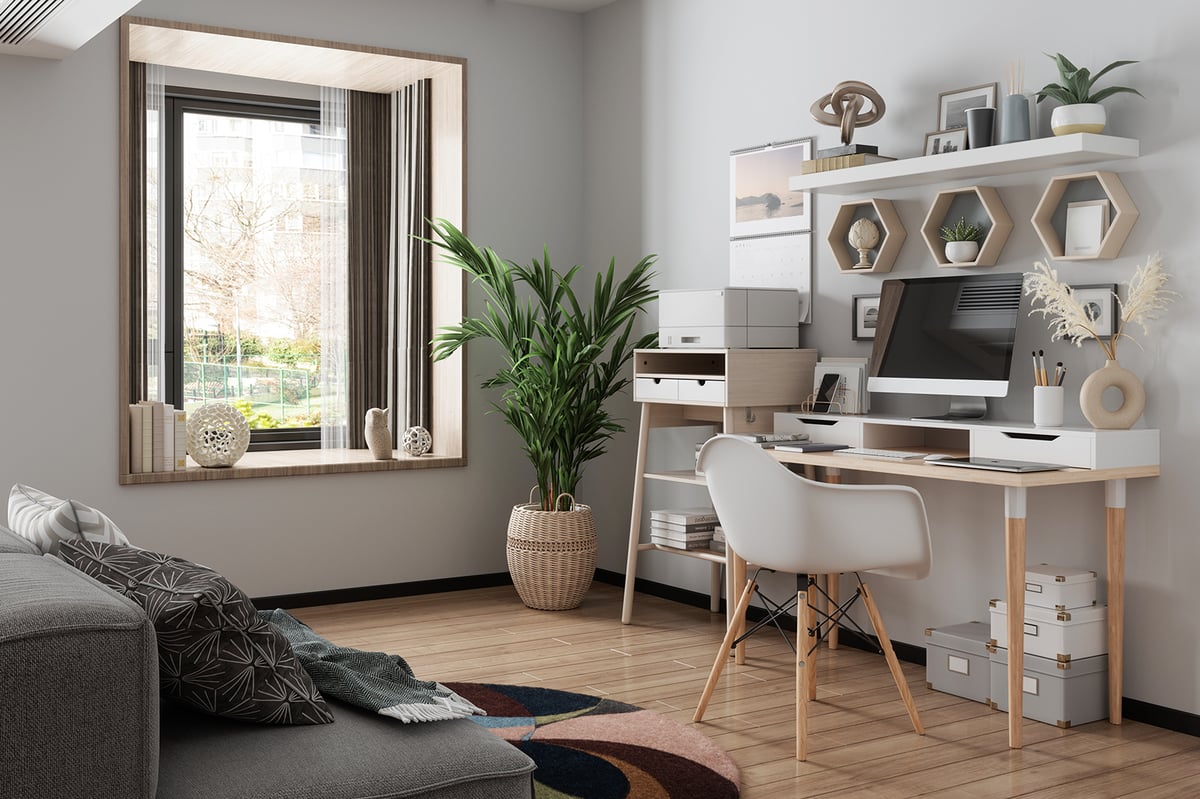I. Introduction
The way we work has changed dramatically in recent years, with more people than ever embracing the work-from-home lifestyle. Whether you're a technical professional or a remote employee in any industry, having a functional and comfortable home office space is essential to staying productive and maintaining a healthy work-life balance. In this blog post, we'll explore the key components of designing your ideal home office setup, from ergonomics and organization to technology and personalization. By the end, you'll have the knowledge and inspiration to create a workspace that maximizes both comfort and productivity.

II. Ergonomics and Comfort
When designing your ideal home office setup, one of the most important factors to consider is ergonomics. Ergonomics is the science of designing a workspace to best fit the needs of the individual using it, promoting good posture and reducing the risk of injury or discomfort. By paying attention to ergonomics, you can create a workspace that not only keeps you comfortable throughout the day but also enhances your productivity. Here are some key aspects of ergonomics to consider when setting up your home office:
Desk Height
The right desk height can make a significant difference in your comfort and productivity. Ideally, your desk should be at a height that allows you to maintain a neutral posture while sitting or standing. Your arms should be at a 90-degree angle when typing, and your wrists should be straight. If your desk is too high, it can cause shoulder and neck strain; if it's too low, it can lead to wrist and back pain. To find the perfect desk height, consider using an adjustable standing desk that lets you switch between sitting and standing throughout the day.
Personally, I have this FlexiSpot Standing Desk and love it. The hydraulic height adjustment is smooth and easy to control, it will work for people who are quite short or tall, and has several size options.
Chair Selection
Investing in a high-quality, ergonomic office chair is essential for maintaining good posture and minimizing discomfort. Look for a chair with adjustable height, armrests, and lumbar support to ensure it can be tailored to your body's unique needs. Additionally, choose a chair with a breathable fabric or mesh to keep you cool during long work sessions.
The Steelcase Gesture is an unbeatable chair, especially if you're looking to spend under $2000. The Gesture offers an adjustable seat depth, fully adjustable arms that you can move out of the way if you need to, pneumatic seat height adjustment, recline tension adjustment, and 4 position recline lock. It's incredibly durable and will last for years, making the cost per use quite good.
Monitor Placement
Proper monitor placement is crucial for avoiding eye strain and maintaining good posture. Your monitor should be positioned at eye level, so you don't have to tilt your head up or down to view the screen.

Ideally, you should have two height adjustable monitors or an adjustable monitor stand to ensure your screens are at eye level. The top of the screen should be at or slightly below eye level, and the screen should be about an arm's length away from your face. If you use multiple monitors, arrange them in a way that minimizes head and neck movement when switching between screens.
Keyboard and Mouse Placement
To prevent wrist strain and maintain a neutral posture, your keyboard and mouse should be placed on a surface that allows your elbows to rest at a 90-degree angle when typing. If your desk doesn't provide the ideal height, consider using an ergonomic keyboard or an adjustable keyboard stand. Additionally, choose a mouse that fits comfortably in your hand and supports your wrist to reduce the risk of developing repetitive strain injuries.
III. Lighting and Ambiance
The quality of lighting in your home office can have a significant impact on both your productivity and overall well-being. Good lighting not only helps reduce eye strain and fatigue but also creates a pleasant and inviting atmosphere that can boost your mood and motivation. Here are some important factors to consider when designing the lighting and ambiance for your home office:
Natural Light
Natural light is highly beneficial for your mental and physical health, and it has been shown to improve mood, focus, and productivity. When setting up your home office, try to position your desk near a window to take advantage of natural sunlight. Make sure to also consider the window's orientation, as direct sunlight can cause glare on your screen or create uncomfortable hotspots. If possible, use light-filtering window treatments to diffuse direct sunlight and minimize glare.
Desk Lamps and Overhead Lighting
In addition to natural light, a combination of task and overhead lighting in your home office is optimal. Task lighting, such as a desk lamp, provides focused illumination for specific tasks like reading or writing. Choose a lamp with adjustable brightness levels and a flexible neck so you can direct the light where you need it most. Overhead lighting, on the other hand, provides general illumination for the entire room. Consider installing dimmable LED bulbs to give you control over the intensity of light, and avoid harsh fluorescent lights that can cause eye strain and headaches.
Avoiding Glare
Glare can cause eye strain and discomfort, so it's essential to take steps to minimize it in your home office. Position your monitor perpendicular to windows to avoid direct sunlight on your screen, and consider using an anti-glare screen protector for your monitor to further reduce glare and reflections.
IV. Organizing Your Workspace
A well-organized workspace is crucial for maintaining focus and productivity in your home office. A clutter-free environment can help reduce distractions and make it easier to find the tools and resources you need throughout the day. Here are some tips and strategies for maintaining an organized and clutter-free home office:
Storage Solutions
Effective storage solutions can help you keep your workspace tidy and organized. Consider investing in a combination of shelves, drawers, and cabinets to store your office supplies, paperwork, and personal items. When selecting storage solutions, prioritize functionality and accessibility to ensure you can easily find and retrieve items when needed. Even something simple, like attachable drawers for your standing desk can make a noticeable difference.
Cable Management
Cable clutter can quickly become an eyesore and create a disorganized workspace. Invest in cable management solutions like cable organizers, cable clips, or cable sleeves to keep cords neat and tidy. Consider using a cable tray or a cable management box to hide power strips and excess cables out of sight. Proper cable management not only makes your workspace look more organized but also reduces the risk of tripping over cords or damaging your devices.
Desk Accessories and Organizers
Desk organizers and accessories can help keep your workspace clean and clutter-free, making it easier to focus on your tasks. Use drawer dividers, pen holders, paper trays, and file organizers to keep your office supplies and paperwork in order. Additionally, consider using a monitor stand with built-in storage compartments or a desk shelf to create additional space for your items while keeping them within easy reach.
V. Personalizing Your Space
While functionality and organization are crucial components of a home office, you also want to create a space you enjoy being in. Here are some ideas for adding personal touches to your home office:
Plants
Incorporating plants into your home office not only adds a touch of nature and beauty but also provides numerous health benefits. Plants can help purify the air, reduce stress, and boost your mood. Choose low-maintenance plants like snake plants, pothos, or succulents if you're new to plant care, or explore a variety of indoor plants to find the ones that best suit your space and preferences.
Wall Art and Decorations
Displaying art and decorations on your office walls can create an inspiring and visually appealing environment. Consider hanging framed prints, photographs, or posters that reflect your interests, passions, or favorite quotes. You can also add a personal touch by creating a gallery wall with a mix of artwork, photos, and other decorative elements that showcase your personality and style.
Color Schemes and Themes
The colors and themes you choose for your home office can greatly influence the atmosphere and your overall mood. Select a color scheme that resonates with you and promotes the desired vibe, whether it's calming, energizing, or creative. Light and neutral colors can create a sense of spaciousness and serenity, while bold or bright colors can add energy and vibrancy to the space. When selecting a theme, consider incorporating elements that reflect your interests, hobbies, or career to create a cohesive and inspiring workspace.
VI. Conclusion
Designing your ideal home office setup is crucial for staying productive, focused, and comfortable while working from home. By paying attention to ergonomics, you can maintain good health and prevent injuries, while proper lighting and ambiance can positively impact your productivity and well-being. Keeping your workspace organized and clutter-free allows you to focus on your tasks, and personalizing your space creates an inspiring and enjoyable environment that truly reflects your personality and style.
Investing time and effort into creating a functional and personalized home office setup can greatly enhance your work-from-home experience. With the right combination of comfort, organization, and personal touches, you can create a workspace that truly supports your success and well-being.







